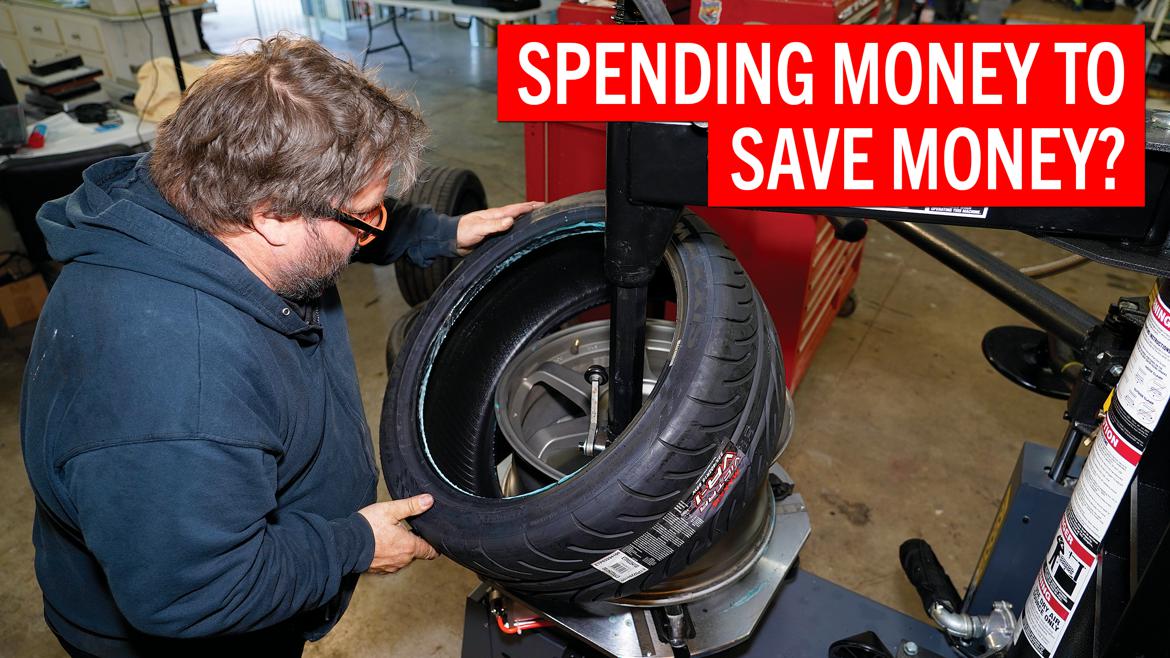
Well, I was planning on putting a diesel in the Bonny so I knew the 8.2" wouldn't hold up. I had been looking for a 12 bolt, and they were rare and expensive. I decided to settle for a much cheaper (but slightly weaker) truck 12 bolt. It was the right width (within an inch - easy to fix with offset). I went to a truck junkyard in Blairsville, PA. I told the guy what I was doing and he had a better idea. He disappeared into the yard with a forklift and came back with a 14 bolt full-floater axle. He said "measure that." Perfect size. I welded on brackets for the trailing arms and bolted it in.
Then I needed 8-lug fronts. I could have probably found an 8-lug disc to fit on my spindle, but I didn't. I found some 3/4 ton spindles from a 78 2wd chevy. I started digging through the catalogs and wrote down all the specs of the parts original to the Bonny; ball joint taper, installation type, etc. The truck upper joints were a bolt-in. The bolt pattern was the same, but the ball itself was bigger, so I had to massage the big hole to get the cup to fit. The lowers I can't remember what I used. It was some one-off GM application like a FWD Caddy or something. I remember enlarging two of the bolt holes because the bolt pattern was slightly different. Everything worked pretty well, but there is a notable bumpsteer issue. The truck steering arm is too high. The car is completely disassembled for body work right now so I just have a tie rod in it to physically hook it up for pushing it around, but I will likely cut off the truck steering arm and bolt one on with a better geometry.
... so not a perfect bolt-on, but didn't take much modification.
Another idea, you could take a chunk of thick wall roll cage tubing, weld a plate on one end with a GM ball joint taper hole cut in it, and a piece on the other end that's a disk with a GM ball joint stud protruding from it. Then cut a window in the tube big enough to pass a nylock nut and swing a (possibly modified to minimize the size of the window) 12pt wrench. As long as the window doesn't take out more than say, 1/3 of the tubing diameter, and you design it to put the load on the flat on top of the spindle, rather than entirely through the stud(this will require hand fitting the spacer to the spindle), it should be plenty strong.
What year Bonneville? Mid 60s?
I wonder if the steering arm is too high enough that you could get the bumpsteer close enough if you flipped the tie rod to the bottom, if it's not there already. Longitudinal-drivetrain VW guys re-taper their steering arms to flip the tie rod all the time.

Vigo
PowerDork
2/8/15 9:25 p.m.
I've been waiting for years for someone to make some ball joint spacers for my K-cars. I've finally come to the conclusion that i better just extend my spindles myself if i ever want anything to happen. Luckily my ball joints are not tapered which makes it easier.
Vigo wrote:
I've been waiting for years for someone to make some ball joint spacers for my K-cars. I've finally come to the conclusion that i better just extend my spindles myself if i ever want anything to happen. Luckily my ball joints are not tapered which makes it easier.
someone makes tall balljoints for Neons, which are essentially just K cars with even lighter duty front suspension parts under them..
In reply to Vigo:
MK1 VW's and Porsche 924's work. Use the same spindle diameter (the larger one). My Uncle used them on his GLH Autocrosser. He welded them to the bottom of the upright since he hillclimbs with it.
Not many bother because generally K-car folks won't pay the money for real suspension outside of the occasional hardcore nut and they generally are crazy enough to just roll their own.
Just trying to get them to understand how bad the sway bar design is and that removing the binding will help their handling is an uphill battle. Instead they all just lock the suspension solid and enjoy rattling their kidney's out.
Knurled wrote:
What year Bonneville? Mid 60s?
I wonder if the steering arm is too high enough that you could get the bumpsteer close enough if you flipped the tie rod to the bottom, if it's not there already. Longitudinal-drivetrain VW guys re-taper their steering arms to flip the tie rod all the time.
The Bonneville was just a sidetrack. The car I'm working with is a 67 LeMans. Tie rod end is already on the bottom.
































